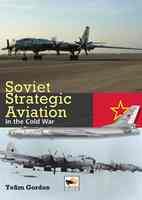Soviet Strategic Aviation in the Cold War [978190210908]
Date Added: Monday 04. January, 2010
Right after WWII, there were three powers that had strategic aviation; the US, UK and Soviet Union. All three countries developed nuclear weapons and the means by which they could be delivered. In this new book by Hikoki, noted author and expert on Soviet military aviation, Yefim Gordon, tells the Soviet part of the story.
When WWII ended, the Soviets did not really have much in the way of a long range strategic bomber force. Yes, they did have the Pe-8, but it was an antiquated design as most of their war-time efforts went into tactical fighters and bombers. Through serendipity, the Soviets were able to get their hands on a top rate, long range, strategic bomber, the B-29 as several had diverted to Vladivostok where they were interred by the Soviets. By taking them apart and doing some reverse engineering, the Soviet Tu-4 became their first very long range bomber. Just in time to help them with their nuclear bomb program as nothing else was available to carry such a weapon.
In this book we look at all of the strategic bombers developed by the Soviets from the prop driven Tu-4 up until today's Tu-160 Blackjack. this includes a look at the Tu-16, M-4, Tu-22, Tu-95 and Tu-22M. There is a section on Arctic aviation, how the force is comprised today in a time of tight budgets, How these planes were used to support those nations friendly to the Soviets and how they were used in combat during the Soviet invasion of Afghanistan.
Throughout the book are an incredible number of photographs of these aircraft, the majority of them in full color. This is further enhanced by over 60 full color profiles and numerous line drawings of each important aircraft type.
It is a book that I am positive you will very much enjoy reading and belongs on the shelves of any student of Soviet military aviation and long range bombers. A book I can easily recommend to you.
Modelling Madness December 2009
When WWII ended, the Soviets did not really have much in the way of a long range strategic bomber force. Yes, they did have the Pe-8, but it was an antiquated design as most of their war-time efforts went into tactical fighters and bombers. Through serendipity, the Soviets were able to get their hands on a top rate, long range, strategic bomber, the B-29 as several had diverted to Vladivostok where they were interred by the Soviets. By taking them apart and doing some reverse engineering, the Soviet Tu-4 became their first very long range bomber. Just in time to help them with their nuclear bomb program as nothing else was available to carry such a weapon.
In this book we look at all of the strategic bombers developed by the Soviets from the prop driven Tu-4 up until today's Tu-160 Blackjack. this includes a look at the Tu-16, M-4, Tu-22, Tu-95 and Tu-22M. There is a section on Arctic aviation, how the force is comprised today in a time of tight budgets, How these planes were used to support those nations friendly to the Soviets and how they were used in combat during the Soviet invasion of Afghanistan.
Throughout the book are an incredible number of photographs of these aircraft, the majority of them in full color. This is further enhanced by over 60 full color profiles and numerous line drawings of each important aircraft type.
It is a book that I am positive you will very much enjoy reading and belongs on the shelves of any student of Soviet military aviation and long range bombers. A book I can easily recommend to you.
Modelling Madness December 2009
Rating:  [5 of 5 Stars!]
[5 of 5 Stars!]







